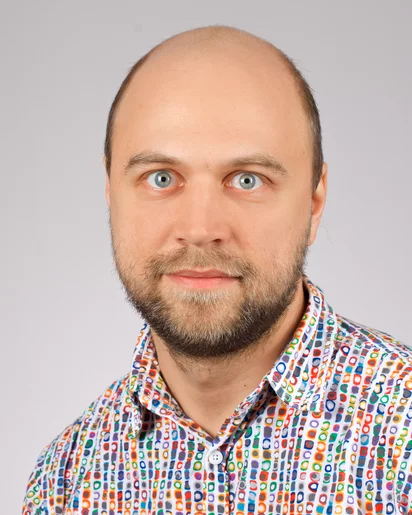Biography
Grigory Smolentsev is a beamline scientist at Paul Scherrer Institute working on pump-probe X-ray spectroscopy. In December 2019 he has completed the Habilitation (Physical and Mathematical Science) at Southern Federal University, Russia. His earlier degrees including Ph.D. in Physical and Mathematical Science (2006) , MSc in Physics (2003) and BSc in Physics (2001) are from Rostov State University, Russia. His early career was centered on the development and application of methods for theoretical analysis of X-ray absorption and emission spectra. During his PhD and a few years after that, he had multiple fellowships to European Synchrotron Radiation Facility being visiting scientist at ID26, ID24, and BM8 beamlines. In 2008 he started research in the field of pump-probe X-ray spectroscopy being involved in collaborative grant with Lin X Chen from Argonne National Laboratory. During PostDoc fellowship at Lund University (Sweden) Grigory Smolentsev has started the transition from theoretical to experimental work. In 2011 he started his career as experimentalist at Paul Scherrer Institute working on the development of pump-probe X-ray spectroscopic techniques first as a Post. Doc. at SuperXAS beamline then being promoted in 2015 to the scientist position. Honors include an International X-ray Absorption Society Award (Farrel Lytle prize).
Institutional Responsibilities
Development, implementation, operation, and maintenance of time-resolved laser pump X-ray probe spectroscopy techniques at SLS beamlines belonging to the Laboratory for Synchrotron Radiation and Femtochemistry (SuperXAS, MicroXAS and Phoenix), development of the strategy for time-resolved laser pump-X-ray probe spectroscopy at SLS 2.0. Time-resolved research in the field of photocatalysis and more general investigation of photo-induced processes. Support of the time-resolved laser pump X-ray probe research with internal and external user groups. Establish a bridge between experiments and scientific drivers at SLS and SwissFEL.
Scientific research
Smolentsev’s scientific research is currently focused on the investigation of molecular materials for solar energy conversion to electricity and fuel, (artificial photosynthesis), and conversion of electricity back to light (OLED materials). Intermediate states of photocatalytic systems for hydrogen production from water, short-lived excited states of photosensitizers and luminophores for organic light-emitting diodes are investigated using pump-probe X-ray absorption and emission spectroscopy.
Selected Publications
For an extensive overview we kindly refer you to our publication repository DORA
Taking a snapshot of the Triplet Excited State of an OLED Organometallic Luminophore using X-rays G. Smolentsev, C. J. Milne, A. Guda, K. Haldrup, J. Szlachetko, N. Azzaroli, C. Cirelli, G. Knopp, R. Bohinc, S. Menzi, G. Pamfilidis, D. Gashi, M. Beck, A. Mozzanica, D. James, C. Bacellar, G. F. Mancini, A. Tereshchenko, V. Shapovalov, W. M. Kwiatek, J. Czapla-Masztafiak, A. Cannizzo, M. Gazzetto, M. Sander, M. Levantino, V. Kabanova, E. Rychagova, S. Ketkov, M. Olaru, J. Beckmann, M. Vogt Nature Communications 11 (2020) 2131 OLED technology beyond small or expensive devices requires light-emitters, luminophores, based on earth-abundant elements. Understanding and experimental verification of charge transfer in luminophores are needed for this development. An organometallic multicore Cu complex comprising Cu–C and Cu–P bonds represents underexplored type of luminophore. To investigate the charge transfer and structural rearrangements in this material, we apply complementary pump-probe X-ray techniques: absorption, emission, and scattering including pump-probe measurements at the X-ray free-electron laser SwissFEL. We find that the excitation leads to charge movement from C- and P- coordinated Cu sites and from the phosphorus atoms to phenyl rings; the Cu core slightly rearranges with 0.05Å increase of the shortest Cu–Cu distance. The use of Cu cluster bonded to the ligands through C and P atoms is an efficient way to keep structural rigidity of luminophores. Obtained data can be used to verify computational methods for the development of luminophores.
Structure of the CoI intermediate of a cobalt pentapyridyl catalyst for hydrogen evolution revealed by time‐resolved X‐ray spectroscopy G. Smolentsev, M. A. Soldatov, B. Probst, C. Bachmann, N. Azzaroli, R. Alberto, M. Nachtegaal, J. A. van Bokhoven Chem. Sus. Chem. 11 (2018) 3087 Cobalt polypyridyls are highly efficient water‐stable molecular catalysts for hydrogen evolution. The catalytic mechanism explaining their activity is under debate and the main question is the nature of the involvement of pyridyls in the proton transfer: the pentapyridyl ligand, acting as a pentadentate ligand, can provide stability to the catalyst or one of the pyridines can be involved in the proton transfer. Time‐resolved Co K‐edge X‐ray absorption spectroscopy in the microsecond time range indicates that, for the [CoII(aPPy)] catalyst (aPPy=di([2,2′‐bipyridin]‐6‐yl)(pyridin‐2‐yl)methanol), the pendant pyridine dissociates from the cobalt in the intermediate CoI state. This opens the possibility for pyridinium to act as an intramolecular proton donor. In the resting state, the catalyst returns to the original six‐coordinate high‐spin CoII state with a pentapyridyl and one water molecule coordinating to the metal center. Such a bifunctional role of the polypyridyl ligands can be exploited during further optimization of the catalyst.
Pump-probe XAS investigation of the triplet state of Ir photosensitizer with chromenopyridinone ligands G. Smolentsev, K. M.van Vliet, N. Azzaroli, J. A. van Bokhoven, A. M. Brouwer, B. de Bruin, M. Nachtegaal, M. Tromp, Photochem Ptotobiol Sci. 17 (2018) 896 The triplet excited state of a new Ir-based photosensitizer with two chromenopyridinone and one bipyridine-based ligands has been studied by pump–probe X-ray absorption near edge structure (XANES) spectroscopy coupled with DFT calculations. The excited state has a lifetime of 0.5 μs in acetonitrile and is characterized by very small changes of the local atomic structure with an average metal–ligand bond length change of less than 0.01 Å. DFT-based calculations allow the interpretation of the XANES in the energy range of ∼50 eV around the absorption edge. The observed transient XANES signal arises from an additional metal-centered Ir 5d vacancy in the excited state which appears as a result of electron transfer from the metal to the ligand. The overall energy shift of the excited state spectrum originates from the shift of 2p and unoccupied states induced by screening effects. The approach for the analysis of time-resolved spectra of 5d metal complexes is quite general and can also be used if excited and ground state structures are significantly different.
Time-resolved X-ray absorption spectroscopy for the study of molecular systems relevant for artificial photosynthesis G. Smolentsev, V. Sundstrom Coord. Chem. Rev. (2015) 304–305, 117–132. Transition metal coordination compounds have a rich photochemistry and are interesting candidates as both light harvesters (photosensitizers) and catalysts in photocatalytic systems. Knowledge of electronic and molecular structure of excited states of photosensitizers and intermediates of catalysts is a key topic for rational design of systems for artificial photosynthesis. We describe recent advances in the field of time-resolved X-ray absorption spectroscopy that provide information on local structure around metal centers, their orbital structure and oxidation state, and thereby insights into the mechanisms of their photochemical reactions. Photosensitizers with metal centers, multicomponent molecular catalytic systems, and supramolecular model sensitizer-catalysts with two metal centers are used as examples to demonstrate the possibilities of the technique. We overview different experimental methods that can be used to investigate intermediates with lifetimes in the range from hundreds of picoseconds to hundreds of microseconds. Theoretical methods to extract the structural and electronic information from X-ray absorption near edge structure spectroscopy (XANES) are also discussed.
Microsecond X-ray Absorption Spectroscopy Identification of CoI Intermediates in Cobaloxime-Catalyzed Hydrogen Evolution G. Smolentsev, B. Cecconi, A. Guda, M. Chavarot-Kerlidou, J. A. van Bokhoven, M. Nachtegaal, V. Artero; Chem. Eur. J. 21 (2015) 15158-15162 Rational development of efficient photocatalytic systems for hydrogen production requires understanding the catalytic mechanism and detailed information about the structure of intermediates in the catalytic cycle. We demonstrate how time‐resolved X‐ray absorption spectroscopy in the microsecond time range can be used to identify such intermediates and to determine their local geometric structure. This method was used to obtain the solution structure of the CoI intermediate of cobaloxime, which is a non‐noble metal catalyst for solar hydrogen production from water. Distances between cobalt and the nearest ligands including two solvent molecules and displacement of the cobalt atom out of plane formed by the planar ligands have been determined. Combining in situ X‐ray absorption and UV/Vis data, we demonstrate how slight modification of the catalyst structure can lead to the formation of a catalytically inactive CoI state under similar conditions. Possible deactivation mechanisms are discussed.


